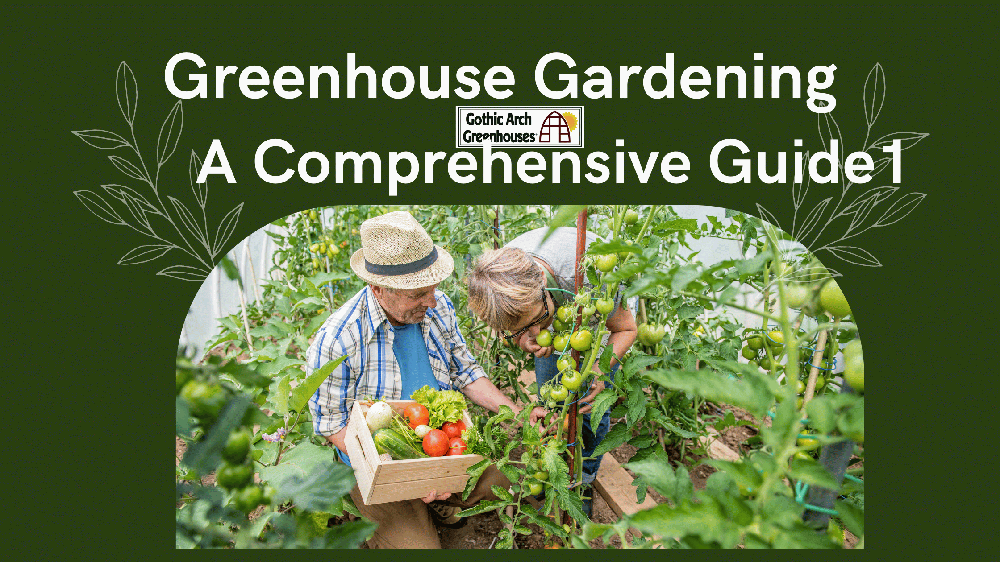
Written by H & B . Sierke (Gothic Arch Greenhouses INC.)
Greenhouse gardening offers a unique and rewarding way to extend the growing season, cultivate a wider variety of plants, and shield crops from adverse weather conditions. By controlling the environment, greenhouse gardeners can optimize conditions for plant growth year-round, regardless of the climate outside. This introductory section will touch on the myriad benefits of greenhouse gardening, from increased yield and plant health to the joy of year-round gardening. Whether for hobbyists looking to indulge their passion or individuals aiming to sustain their households with fresh produce, greenhouse gardening opens up a world of possibilities.
Types of Greenhouses
When it comes to selecting the right greenhouse, gardeners have a variety of options, each with its own set of benefits and challenges. The choice depends on several factors, including climate, space, budget, and the types of plants you wish to grow. Here are the main types of greenhouses to consider:
Traditional Greenhouses
Glass Greenhouses: The classic choice, offering excellent light transmission but can be expensive and fragile. It is ideal for colder climates due to its good insulation properties.
Polycarbonate Greenhouses: A more durable and less costly alternative to glass, with twin-wall polycarbonate sheets that provide good insulation and protect plants from strong sunlight.
Modern Greenhouses
Hoop Houses: Made with steel frames covered in polyethylene, these are cost-effective and easy to construct. However, they offer less insulation than glass or polycarbonate greenhouses.
Geodesic Domes: Known for their strength and ability to distribute light evenly. They can withstand harsh weather conditions but can be more expensive and complex to build.
Mini-Greenhouses
Cold Frames: Simple, small structures designed to protect plants from extreme cold. They're perfect for gardeners with limited space or those looking to extend the growing season for a few plants.
Portable Greenhouses are ideal for those who rent or have limited space. They can be set up and taken down easily but offer less protection and stability than permanent structures.
Climate Control and Environment Management
Creating the ideal environment within a greenhouse is crucial for plant health and productivity. The key elements of climate control include temperature regulation, humidity management, and lighting.
Temperature Regulation
Temperature control is crucial for maintaining a productive greenhouse. Plants thrive in specific temperature ranges, and deviations can hinder growth or even cause harm. Here are key strategies for regulating temperature:
- Ventilation: Incorporating manual or automatic venting systems is essential to expel hot air and introduce cooler air, preventing overheating during warmer months.
- Heating: In colder climates, maintaining a warm environment is necessary. Options range from electric and gas heaters to more sustainable solutions like solar panels or geothermal heating, depending on the greenhouse size and budget.
- Thermal Mass: Using materials that absorb heat during the day and release it at night (e.g., water barrels or stones) can help stabilize temperature fluctuations.
Humidity Control
Proper humidity levels are vital for preventing diseases and ensuring plant health. Too much humidity can lead to fungal infections, while too little can stress plants.
- Ventilation Again: In addition to temperature control, ventilation helps manage humidity levels by removing moist air and bringing in drier air from the outside.
- Water Management: Employing drip irrigation or soil moisture systems can reduce excess humidity by minimizing water waste and preventing surface evaporation.
- Dehumidifiers: In tightly sealed greenhouses, dehumidifiers might be necessary to actively remove moisture from the air, especially in very humid climates or during winter when ventilation options are limited.
Lighting
Light is a critical factor for plant growth, affecting photosynthesis, flowering, and crop yield. Managing light involves ensuring adequate light levels and protecting plants from excessive light.
- Supplemental Lighting: In regions with short days or during winter months, additional lighting may extend the growing season. LED grow lights are efficient and can be tailored to the specific light spectrum needs of different plants.
- Shade Systems: During peak sunlight hours, particularly in summer, shade cloths or retractable roof systems can protect plants from too much direct sunlight, reducing stress and preventing leaf burn.
Automated Systems for Climate Control
Advancements in technology have made it easier for greenhouse owners to manage the environment:
- Automated Ventilation and Shading: These systems can open vents, turn on fans, or extend shade cloths based on temperature and light sensors, ensuring optimal conditions without constant manual adjustment.
- Smart Thermostats and Humidity Controllers: Connected devices can monitor and adjust heating, cooling, and dehumidification systems, maintaining precise environmental conditions and even alerting owners to issues via smartphone apps.
Implementing Effective Climate Control
The key to effective climate control in a greenhouse lies in careful planning, regular monitoring, and adjusting strategies as needed. Gardeners should start with a clear understanding of their plants' specific needs and then select and implement control systems that meet those needs within their budget and capability.
As we've explored, managing the microclimate of a greenhouse involves a delicate balance of temperature, humidity, and lighting. By effectively controlling these elements, gardeners can overcome many of the challenges associated with outdoor gardening, leading to healthier plants and more abundant yields.
